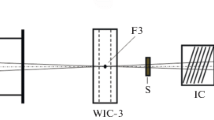Abstract
We studied the effects of irradiation with X-rays (the total dose of 0.0129 C/kg was attained over 7, 14, or 21 days), increased entry of Al3+ into the organism (0.2% AlCl3 in drinking water), and the combined influence of these factors for 21 days on the contents of the soluble and filamentous forms of glial fibrillary acidic protein (GFAP) in the tissues of the hippocampus, cerebellum, and neocortex of albino rats. After irradiation for 7 days, a clear trend toward drops in the GFAP contents in the structures under study was observed, while irradiation in the same dose, but for 14 or 21 days, resulted in increases in the contents of both GFAP forms (within a range of 13-29%, as compared with the control). Entry of aluminum chloride with water also resulted in an increase in the GFAP contents in all studied structures; changes in the filamentous form were more intensive. The combined influence of irradiation and Al3+ resulted in more intensive shifts in the GFAP levels; the content of its filamentous form increased in all structures by about 50%, while shifts of the soluble form were somewhat smaller.
Similar content being viewed by others
REFERENCES
B. A. Berezin, G. M. Shevchenko, G.G. Bunyatyan, et al., “Spe-cific proteins of intermediate filaments in normal nerve tissue and in brain tumors,” Neirokhimiya, 6, No. 2, 77-82 (1987).
B. Holmberg, L. Rosengren, J. E. Karlsson, and B. Johnels, “ln-creased cerebrospinal fluid levels of neurofilament protein in pro-gressive supranuclear palsy and multiple-system atrophy compared with Parkinson's disease,” Movement Disorders, 13, No. 1, 70-77 (1996).
B. Inoue, S. Yagishi, Y. Hoh, et al., “Coexistence of paired helical filaments and polyglucosan bodies in the same neuron in an autopsy case of Alzheimer's disease,” Acta Neuropathol., 90, No. 5, 511-514 (1996).
M. Yamszaki, I. Nakano, O. Imazu, and A. Terashi, “Paired helical filaments and straight tubules in astrocytes: an electron microscopic study in dementia of the Alzheimer type,” Acta Neuropathol., 90, No. 1, 31-36 (1995).
V. S. Nedzvetskii, S. G. Busygina, V. A. Berezin, and A. I. Dvoretskii, “CNS syndrome. Characterization of the intermediate filaments in the rat brain,” Radiobiologiya, 30, Issue 2, 243-246 (1990).
V. S. Nedzvetskii, G. A. Ushakova, S. G. Busygina, et al., “Effect of small doses of ionizing radiation on the intermediate filaments and Ca 2+-activated system of proteolysis in the rat brain,” Radio-biologiya, 31, Issue 3, 333-339 (1991).
J. F. Leterier, D. Langui, A. Probst, and I. Ulrich, “A molecular mechanism for the induction of neurofilament bundling by aluminium ions,” J. Neurochem., 58, 755-760 (1992).
V. S. Nedzvetskii, V. A. Berezin, T. I. Obernyak, and E. N. Zhmareva, “Characterization of specific proteins of the intermediate filaments in brain tumors of humans,” Biokhimiya, 51, No. 11, 1843-1850 (1986).
G. L. Miller, “Protein determination for large numbers of samples,” Anal. Chem., 31, No. 5, 964-966 (1959).
V. S. Nedzvetskii and P. A. Nerush, “Protein of the glial intermediate filaments in different regions of the rat brain in experimental neurosis,” Neirofiziologiya/Neurophysiology, 31, No. 2, 115-119 (1999).
Z. Somosy, M. Sass, G. Bognar, et al., “X-irradiation-induced disorganization of cytoskeletal filaments and cell contacts in HT29 cells,” Scanning Microscopy, 9, No. 3, 763-772 (1995).
T. B. Shea, M. L. Beermann, and R. A. Nixon, “Aluminium treatment of intact neuroblastoma cells alters neurofilament subunit phosphorylation, solubility, and proteolysis,” Mol. Clin. Neuropathol., 26, No. 1, 1-14 (1995).
E. Petersen, H. V. Nielsen, L. Christiansen, and J. Spenter, “Immunization with E. coli produced recombinant T. gondii SHG1 with alum as adjuvant to protect mice against lethal infection with Toxoplasma gondii,” Vaccine, 16, No. 13, 1283-1289 (1998).
M. G. Tari, M. Mancino, E. Ghezi, et al., “Immunotherapy with an alum adsorbed parietoria-pollen allergoid: a 2-year, double-blind, placebo-controlled study,” Eur. J. Allergy Clin. Immunol., 52, No. 1, 65-74 (1997).
W. F. Huff, P. A. Moore, J. M. Balog, et al., “Evaluation of the toxicity of alum (alum sulfate) in young broiler chickens,” Poultry Sci., 75, No. 11, 1359-1365 (1996).
G. Pagano, E. His, R. Beiras, et al., “Cytogenetic, developmental, and biochemical effects of aluminium, iron, and their mixture in sea urchins and mussels,” Arch. Environment. Contaminat. Toxicol., 31, No. 4, 466-474 (1996).
T. Shea, J. Clarke, T. Whelock, et al., “Aluminium salts induce the accumulation of neurofilaments in perykaryal of NB 2a/dl neuro-blastoma,” Brain Res., 14, No. 5, 53-64 (1998).
W. Jeglinski, D. Koczuk, M. Zaremba, et al., “Bilateral gliosis in unilaterally lesioned septohippocampal system: changes in GFAP immunoreactivity and content,” J. Neurosci. Res., 41, No. 3, 394-402 (1995).
R. A. Yokel and J. P. O'Calladhan, “An aluminium-induced in-crease in GFAP is attenuated by some chelators,” Neurotoxicol. Teratol., 20, No. 1, 55-60 (1998).
Z. Gong, A. R. Little, H. el-Fawal, and H. L. Evans, “Trimethyl lead neurotoxicity in the rat: changes in glial fibrillary acidic protein,” Arh. Aigijenu Rada Toksikol., 46, No. 4, 381-390 (1995).
C. W. MacDiarmid and R. C. Gardner, “Al3+ toxicity in yeast. A role for Mg2+?” Plant Physiol., 112, No. 3, 1101-1109 (1996).
B. P. He and M. J. Strong, “A morphological analysis of motor neuron degeneration and microglial reaction in acute and chronic in vivo aluminium chloride neurotoxicity,” J. Chem. Neuroanat., 17, No. 4, 207-215 (2000).
Author information
Authors and Affiliations
Rights and permissions
About this article
Cite this article
Nedzvetskii, V.S., Nerush, P.A., Tikhomirov, A.A. et al. Effects of Ionizing Radiation and Aluminum Chloride on Protein of Glial Intermediate Filaments in the Rat Brain. Neurophysiology 33, 28–33 (2001). https://doi.org/10.1023/A:1010460130068
Issue Date:
DOI: https://doi.org/10.1023/A:1010460130068




